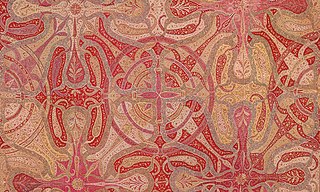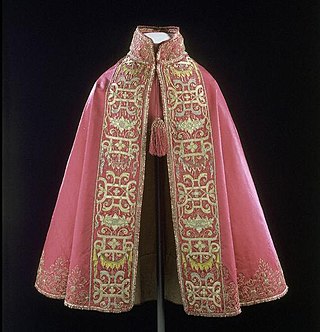
Textile is an umbrella term that includes various fiber-based materials, including fibers, yarns, filaments, threads, different fabric types, etc. At first, the word "textiles" only referred to woven fabrics. However, weaving is not the only manufacturing method, and many other methods were later developed to form textile structures based on their intended use. Knitting and non-woven are other popular types of fabric manufacturing. In the contemporary world, textiles satisfy the material needs for versatile applications, from simple daily clothing to bulletproof jackets, spacesuits, and doctor's gowns.

Yarn is a long continuous length of interlocked fibres, used in sewing, crocheting, knitting, weaving, embroidery, ropemaking, and the production of textiles. Thread is a type of yarn intended for sewing by hand or machine. Modern manufactured sewing threads may be finished with wax or other lubricants to withstand the stresses involved in sewing. Embroidery threads are yarns specifically designed for needlework. Yarn can be made of a number of natural or synthetic materials, and comes in a variety of colors and thicknesses. Although yarn may be dyed different colours, most yarns are solid coloured with a uniform hue.
This timeline of clothing and textiles technology covers the events of fiber and flexible woven material worn on the body; including making, modification, usage, and knowledge of tools, machines, techniques, crafts, and manufacturing systems (technology).

Rayon is a semi-synthetic fiber, made from natural sources of regenerated cellulose, such as wood and related agricultural products. It has the same molecular structure as cellulose. It is also called viscose. Many types and grades of viscose fibers and films exist. Some imitate the feel and texture of natural fibers such as silk, wool, cotton, and linen. The types that resemble silk are often called artificial silk.

Pashmina refers to, depending on the source, a term for cashmere wool of the Changthangi cashmere goat, for fine Indian cashmere wool or a synonym for cashmere wool.

Country of origin (CO) represents the country or countries of manufacture, production, design, or brand origin where an article or product comes from. For multinational brands, CO may include multiple countries within the value-creation process.

Beetling is the pounding of linen or cotton fabric to give a flat, lustrous effect.
Azlon is a synthetic textile fiber composed of protein material derived from natural sources such as soy, peanut, milk or corn. Currently it is used in clothing.
Elasterell is an alternative to the generic term "polyester" for a specific subgroup of inherently elastic, multicomponent textile fibers.

Primarily, nap is the raised (fuzzy) surface on certain kinds of cloth, such as velvet or moleskin. Nap can refer additionally to other surfaces that look like the surface of a napped cloth, such as the surface of a felt or beaver hat.

Bamboo textile is any cloth, yarn or clothing made from bamboo fibres. While historically used only for structural elements, such as bustles and the ribs of corsets, in recent years different technologies have been developed that allow bamboo fibre to be used for a wide range of textile and fashion applications.

In textile manufacturing, finishing refers to the processes that convert the woven or knitted cloth into a usable material and more specifically to any process performed after dyeing the yarn or fabric to improve the look, performance, or "hand" (feel) of the finish textile or clothing. The precise meaning depends on context.
The country-of-origin effect (COE), also known as the made-in image and the nationality bias, is a psychological effect describing how consumers' attitudes, perceptions and purchasing decisions are influenced by products' country of origin labeling, which may refer to where: a brand is based, a product is designed or manufactured, or other forms of value-creation aligned to a country. Since 1965, it has been extensively studied by researchers.
Parchmentising or parchmentizing is a kind of aesthetic finish for textiles. It is a finishing treatment for cellulose fabric that stiffens the fabric and imparts a degree of translucency.

A gig-mill was type of raising machine that used teasels to produce a nap on cloth. Examples of the results of gigging are woolen fabrics such as chinchilla, beaver cloth, and melton. The process involved gradual teasing of the surface to raise the nap. Spelling in some localities is "Gigg".

In textiles, lustre or luster is a physical property that makes them appear bright, glossy, and shiny. The amount of light reflected from the surface of a fiber is referred to as its luster.The level of luster is determined by how light reflects off the surface. For example, round surfaced fiber reflects more light and appears shinier than fiber with an irregular surface. Synthetic fibers with a more regular surface seem brighter than natural fibers with an irregular surface, with the exception of silk, which has a regular surface.
The cross section depicts the shape of the various textile fibers. Each textile fiber offers a distinct cross sectional appearance when seen under a microscope. The shapes vary from round to oval and flat, different shapes determines certain characteristics of the textiles. Though the majority of synthetic fibers have a circular cross section, but the shape could be altered or engineered during the manufacturing process. The cross-sectional shape is responsible for certain physical properties of textile fibers such as the luster of textiles.
A blend is a mixture of two or more fibers. In yarn spinning, different compositions, lengths, diameters, or colors may be combined to create a blend. Blended textiles are fabrics or yarns produced with a combination of two or more types of different fibers, or yarns to obtain desired traits and aesthetics. Blending is possible at various stages of textile manufacturing. The term, blend, refers to spun fibers or a fabric composed of such fibers. There are several synonymous terms: a combination yarn is made up of two strands of different fibers twisted together to form a ply; a mixture or mixed cloth refers to blended cloths in which different types of yarns are used in warp and weft sides.

Aesthetics in textiles is one of the basic concepts of serviceability of textiles. It is determined by the perception of touch and sight. Aesthetics imply the appearance and attraction of textile products; it includes the color and texture of the material. It is a statement about the end user (consumer) and the target market. When combined with fabric construction, the finish of the clothing material, garment fit, style, and fashion compatibility, colours create an aesthetic comfort. All of these elements work together to satisfy our visual perception. Aesthetics incorporates the role of evaluation also.
The Wool Products Labeling Act, enacted in 1939, provides provisions for the accurate labeling of products containing wool fibers. The purpose of this act is to promote transparency and safeguard consumers and stakeholders in the wool industry from deceptive practices and false information regarding the composition of wool products in the market.












